Joy Neal Kidney's Blog, page 50
August 5, 2022
Purple Heart Day
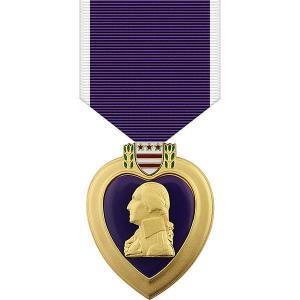
Purple Heart Day is observed every year on August 7, since the medal was created on that day in 1782.
Originally called the Badge of Military Merit, consisting of a cloth purple heart worn over the left breast, it was awarded the first time by General George Washington. It was mostly forgotten until World War I, when a plan for valor and merit medals took shape.
Then in 1932, US Army Chief of Staff Douglas MacArthur reintroduced the old Badge of Military Merit, renaming it the Purple Heart.
The Purple Heart is awarded for combat action only and is awarded to any person wounded in action while serving with the armed forces of the United States, even posthumously.
Designed by Elizabeth Will, the heart-shaped medal, including a profile of Washington, is one of the best known and most beautiful of all US decorations.
Both Dale R. Wilson and Daniel S. Wilson were killed in action during World War II. Both were awarded a Purple Heart. Daniel’s, with his name engraved on the back, was sent to his grieving parents. Dale’s death wasn’t officially declared until January of 1946. I asked for the family to receive his Purple Heart. It is not engraved.
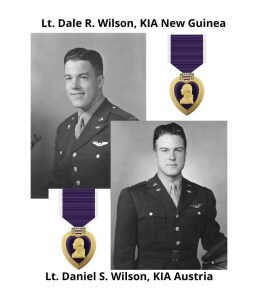
It’s puzzling that the Purple Heart is awarded even for superficial wounds for veterans who survive, but there is no separate medal commemorating those who actually lose their lives.
American Medals and Decorations by Evans Kerrigan
July 30, 2022
Omar Shearer, the First of Our Own Boys to Give His Life, July 30, 1918
German submarines sank three American merchant ship in March, 1917. The US declared war on Germany in April. A month later, the Selective Service Act passed. Men ages 21-30 had to register for the draft. Among the Guthrie County enlistments listed in the May 14 Guthrie Times was a young man named Omar Shearer, age 16.
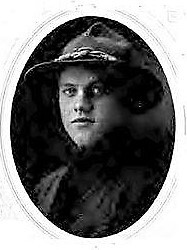
In 1918, he became the first Guthrie County soldier to lose his life. Word didn’t make it to Guthrie Center until a few weeks later:
The Guthrie Times, September 12, 1918:
“Omar Shearer–Who, according to a letter received from one of his comrades by his mother, Anna Shearer, gave his life on the battlefields of France to save the world for God and mankind. His mother has had no official announcement from the government yet, and there is a hope that there may be some possible mistake. A letter was received here from Omar of date July 24, and the letter containing the announcement of his death was of date of August 4. What might have happened in the interim can only be guessed at. It is truly hoped that later news may bring word that it is a mistake.”
The Guthrie Times, September 26, 1918:
Omar Shearer the First of Our Own Boys to Give His Life
He Laid It on the Altar of His Country
Freely and Voluntarily–in the Fiercest of the Battle
He Stood and Was a Victim to the
Cruel and Treacherous Hun Bullet
“. . . Never, in all the years have we more reluctantly, and with deeper sorrow told the story of death, than when we announce the death of Omar Shearer. But amidst our grief we can exclaim–‘What a glorious death to die!’ Only a few short months ago he was a lad in our public schools, free from care, and intent on getting an education, fitting himself for life’s duties and life’s work. But war came and the foundation, principles upon which rested the whole fabric of our great and noble government was threatened. President Wilson announced a state of war existed, and Congress declared war against Germany and a call went out for volunteers. Omar Shearer with others of our own boys was among the first to answer that call. He was large of age, and with the consent of his mother, was accepted and enlisted in the Machine Gun Company of the 168th Regiment. He went into training at the State Fair grounds at Des Moines and learned to be a soldier. . . . When the 168th went over Omar was with them. . . . Some months ago he was gassed and wounded, from which he recovered and was with his command again when the present drive began upon the part of the Allies, and was . . . in the thickest of the fray that, according to a letter from one of the comrades to his mother, he fell. Yes, he shed his blood and gave his life for the noble cause of humanity, for his country’s honor, for freedom, for home and native land. What more could he have done?
“Since the above was in type Omar’s mother received a message from Washington confirming his death, which was sad news indeed, and took away the hope that still lingered in the hearts of his loved ones.
“His death brings the war closer to us all, especially to the people of our little city, most of whom knew him personally, and who loved him for his manly ways and his buoyant disposition. We all hoped and prayed that he might be spared to come back to us and enjoy the fruits of victory won upon the battlefield, but it was not so ordered by Him do doeth all things well. No words of ours can assuage the grief and sorrow of the mother’s heart or console the grandparents and other to whom he was near and dear by the ties of consanguinity, but we can cherish his memory and recall his great sacrifice in our behalf and drop a silent tear with the loved ones. We can see to it too, that this fine young man, who gave his all to insure a world’s peace, shall not have died in vain. And while we all cannot cross the ocean and offer our lives, we can do our part at home. We can make personal sacrifices, give of our substance, and thus help those that are still fighting our battles by all the means of our power.
“The government has promised that the bodies of our hero dead, who died in the foreign fields, should be brought back to their own, their native land, and all that is mortal of Omar will come to us again, but his soul will go back to Him that gave it to live forever and forever. . . . ”
Omar Shearer is buried in the Oise-Aisne American Cemetery in France. There is a cenotaph in his remembrance in the Guthrie Center cemetery. The FindaGrave site gives the death date as July 30, 1918.
The American Legion post at Guthrie Center is named in Omar Shearer’s honor.
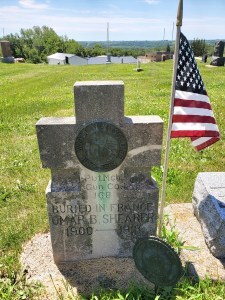
July 27, 2022
The 1936 Berlin Olympics
Some of my favorite stories have come from the 1936 Berlin Olympics, also dubbed the Nazi Olympics, held in August of 1936. Reich Führer Adolph Hitler saw the major international event as an opportunity to promote his government and ideals of racial supremacy and antisemitism. Jewish athletes were barred from taking part.
Jesse Owens
Although Germany won the most medals, overall, with the US coming in second. Jesse Owens of the US won four gold medals, becoming the most successful athlete of the event, effectively rejecting Hitler’s notion of racial supremacy.
The year before, Dexter band marched in the the 1935 Drake Relays parade in Des Moines. Doris Wilson, playing a borrowed trumpet, asked who was the man riding in the parade and waving to the crowd. It was Jesse Owens, famous as a runner even before the Olympics the next year.
—–
Two of my favorite books are about athletes who also competed in the 1936 Berlin Olympics.
Louis Zamperini
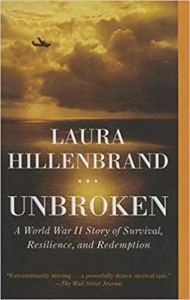 Runner Louis Zamperini came in 8th in his race, but Adolph Hitler insisted on meeting him. Zamperini, who been a troubled youth, found his purpose in running.
Runner Louis Zamperini came in 8th in his race, but Adolph Hitler insisted on meeting him. Zamperini, who been a troubled youth, found his purpose in running.
After WWII broke out, joined the Army Air Force. His B-17 went down in the Pacific, where he spent 47 days adrift, then 2 1/2 years in three Japanese POW camps.
Unbroken: A World War II Story of Survival, Resilience, and Redemption by Laura Hillenbrand is an incredible true story!
The Boys in the Boat
 The Boys in the Boat: Nine Americans and Their Epic Quest for Gold at the 1936 Berlin Olympics by Daniel James Brown is another favorite story from those historic days.
The Boys in the Boat: Nine Americans and Their Epic Quest for Gold at the 1936 Berlin Olympics by Daniel James Brown is another favorite story from those historic days.
I especially enjoyed the backgrounds of the crew, many of whom were dirt poor because of the Great Depression. The book combines the craftsmanship of boat building, superb coaching, laws of physics, psychology, and the mystery of hope. Rewarding and refreshing.
July 25, 2022
Those Goff Reunions
The Goff reunions were part of my childhood. They were held at Springbrook Park north of Guthrie Center, Iowa, which was a WPA project during the Great Depression. We enjoyed all the food and getting to play in the water. The adults enjoyed the food and talking, talking, talking.
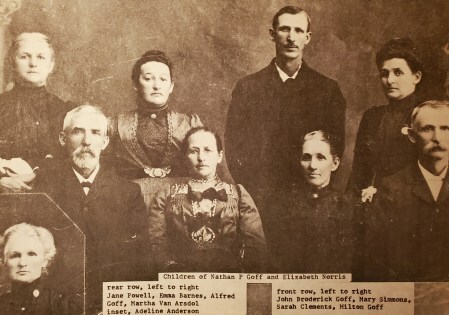 Children of Nathan P. and Elizabeth (Norris) Goff: Back: Jane Powell, Emma Barnes, Alfred Goff, Martha Van Arsdol. Front: (inset) Adeline Anderson, John Broderick Goff (father of Milton Sheridan “Sherd” Goff), Mary Simmons, Sarah Clements, Milton Goff. Milton is the oldest, born in 1840, and Martha the youngest, born 20 years later. All born in Indiana.
Children of Nathan P. and Elizabeth (Norris) Goff: Back: Jane Powell, Emma Barnes, Alfred Goff, Martha Van Arsdol. Front: (inset) Adeline Anderson, John Broderick Goff (father of Milton Sheridan “Sherd” Goff), Mary Simmons, Sarah Clements, Milton Goff. Milton is the oldest, born in 1840, and Martha the youngest, born 20 years later. All born in Indiana.I only knew a few people there, but my Grandma Leora knew all of them! They were related through her father Sherd Goff’s grandparents, Nathan P. And Elizabeth (Norris) Goff.
Nathan and Elizabeth had 11 children, all born in Indiana. One died as a child and one never married. The family came to Madison County, Iowa, in 1863.
While staying with my folks right before Guy left for Vietnam in July of 1969, we attended a Goff reunion. It was held at the park in Winterset, which is the seat of Madison County. Grandma Leora rode there with us.
As the caretaker of the family photos, letters, and clippings, I learned that one year there was a mini-reunion of Goffs, and that it was held at the Sherd and Laura Goff home in Dexter, which still sits along the highway and directly across from what is now the Dexter Park.
 The B.J. Black and Ed Taggart families and Frank Barnes. All cousins. Lucille Black in the picture was chosen as Iowa’s Healthiest Girl at the Iowa State Fair one year. Dexter, Iowa, August 14, 1927. (Ones I recognize in the front row are Dale, Danny, Darlene, and Doris Wilson, with their dad Clabe behind Darlene. Sherd Goff at right with white hair. His wife Laura in is next, then Leora Goff Wilson. The smallest boy is Junior Wilson, who is looking at his cousin Merrill Goff.
The B.J. Black and Ed Taggart families and Frank Barnes. All cousins. Lucille Black in the picture was chosen as Iowa’s Healthiest Girl at the Iowa State Fair one year. Dexter, Iowa, August 14, 1927. (Ones I recognize in the front row are Dale, Danny, Darlene, and Doris Wilson, with their dad Clabe behind Darlene. Sherd Goff at right with white hair. His wife Laura in is next, then Leora Goff Wilson. The smallest boy is Junior Wilson, who is looking at his cousin Merrill Goff.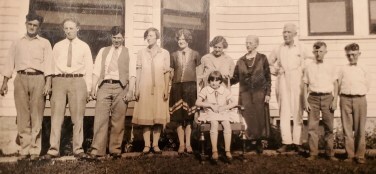 Frank Barnes, Clarence Taggart, Wayne Black, Gladys Taggart Root, Lucille Black (Iowa’s Healthiest Girl this year at the Iowa State Fair), Aunt Mary (Goff) Bonine, M.S. Goff and Therma Black sitting.
Frank Barnes, Clarence Taggart, Wayne Black, Gladys Taggart Root, Lucille Black (Iowa’s Healthiest Girl this year at the Iowa State Fair), Aunt Mary (Goff) Bonine, M.S. Goff and Therma Black sitting.
As I combed through the letters and clippings of the Clabe and Leora Wilson family, working on Leora’s Dexter Stories: The Scarcity Years of the Great Depression, I noticed that nearly every summer, one of Leora’s brothers would drive to Dexter from Omaha, pick up his mother (Laura Goff) and whoever else wanted to go to the Goff Reunion at Springbrook Park north of Guthrie Center. In 1931, Doris (about 13) and her cousin Maxine Goff (about 10) went with them. Grandmother took bananas and cut them in half to serve at the potluck. Mostly the kids chose them, and one of them ate so many he got sick. Doris had never tasted a banana before.
It was there that Doris was taken aback when her younger cousin broke the news that Doris’s mother was going to have another baby. In those days, pregnancy was not discussed with children. Doris should have noticed her mother’s growing girth, but she hadn’t.
But Doris and Maxine very much enjoyed visiting at the Goff Reunions when they were adults.
The History and Genealogy of The Nathan P. Goff Family of Randolph County, West Virginia, Delaware County, Indiana, and Madison County, Iowa. Complied by one of his great grandsons, Colonel Joseph Philip Barnes, 1972.
Are large family reunions part of your memories?
July 20, 2022
Four Generations at a Birthday Party, 1950
 Photo was taken at the Donald and Lucille Shaw place, NW of old Dexfield Park, July 1950.
Photo was taken at the Donald and Lucille Shaw place, NW of old Dexfield Park, July 1950.Both grandmothers, two great grandmothers, Mom, my sister, and two cousins!
On the left: Aunt Betty (Neal) Wells, Dad’s sister, with Vincent Neal Wells (b. 1945). I’m (1944) lugging Candy, a Cocker Spaniel puppy which was actually sister Gloria’s (1946) birthday gift, but she was busy riding her trike. Vince’s sister Patty (1947) is on the other trike.
Next to Aunt Betty is Grandma Ruby (Blohm) Neal (1898 -1991), whose parents were born in Pellworm Island, Germany.
Nellie Edith (Keith) Neal (1869-1955), widow of O.S. Neal. They were Dexter neighbors to the Clabe and Leora Wilson family during the Great Depression. Great Grandma Nellie helped her daughter-in-law make many quilts, including the “Dahlia Star” quilt for the marriage of Warren Neal to Doris Wilson.
Laura (Jordan) Goff (1868-1962). Some of Great Grandmother’s stories are part of the Leora Stories, especially Leora’s Dexter Stories: The Scarcity Years of the Great Depression and Leora’s Early Years: Guthrie County Roots. She helped teach me to crochet and I played Canasta with her.
Leora (Goff) Wilson (1890-1987), Laura’s oldest daughter and the heroine of the Leora Stories.
Doris (Wilson) Neal (1918-2015). Leora’s oldest daughter, my mother.
July 18, 2022
Stonehenge: the day two outvoted three
“Well, can ya die ‘appy now thet ya’ve seen Stonehenge?” he asked.
It was an interesting question, but if you had a chance to visit England, what would be at the top of your list of places to see? Buckingham Palace? Big Ben? Those were on my list, but the top line belonged to England’s most famous pile of rocks, Stonehenge.
Guy and I, along with 14-year-old son Dan, had a chance to visit England the summer of 1989, when Guy’s sister and her husband (Lois and David) lived there, two hours north of London in Kings Lynn. They’d already seen Stonehenge and didn’t think it was worth the extra hour out of our way into London to visit.
I was relieved that the ancient relic was still at the top of Dan’s list (along with Hard Rock Cafe and a Dr. Who exhibit). Somehow the two of us outvoted the other three!
Getting there wasn’t easy. Traffic on the London Orbital was stop-and-go. The car’s open windows gave no relief from the heat and humidity. It was a miserable ride. Guilt nagged. But when we finally headed west, anticipation set in. Without warning, we crested a hill and there, spread out in the distance, was Salisbury Plain.
That first glimpse of the great grey boulders on the lonely expanse reminded me of toy blocks left behind by a gigantic creature that had tired of them. Dark specks dotting the vast isolated pasture turned out to be cows.
What causes the desire to spend time and effort to see ancient haphazard ruins? The enigmatic monument is certainly not a place of beauty, but is strangely alluring. Some of the ungainly stones stood on end, some shared lintels with others, some had fallen over, and many had been hauled away. Since 1978, people have not been allowed to walk among the huge, dull sandstone sarsens and blue-stones, but we circled nearly all the way around them. A solemnity seemed to silence the dozen or so tourists there.
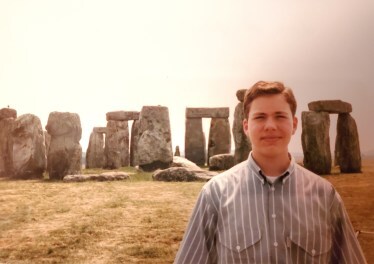 Dan at Stonehenge, June 1989. You can barely see a jackdaw perched on the stone at the left.
Dan at Stonehenge, June 1989. You can barely see a jackdaw perched on the stone at the left.A jackdaw flapped to the top of a massive upright where the silhouette of its mate waited.
I pondered the history and mystery of the place. How did primitive men haul 81 of these giants from 25 miles away, other large stones from as far away as 300 miles?
That was no easier to grasp than this imposing carcass of rocks was a Stone Age astronomical observatory, that the dull grey stones aligned with other stones and spaces so that primitive men could predict the seasons and even eclipses of the sun and moon.
Maybe it’s what we don’t know about this mute place is what makes it magical.
A helicopter circled overhead, insisting on our attention to the modern world. It was the week of the Summer Solstice and the Stones, as they call it, were closed for two days to thwart an invasion of hippies.
Before leaving, we cooled off with colas in the shade of a hawthorn shrub. A cabbie, who had brought more tourists to see the famous relic, asked loudly, “Well, can ya die ‘appy now thet ya’ve seen Stonehenge?” We all laughed.
“As a matter of fact, yes!” I admitted.
When Lois and David visited us at home, after they moved back to the States, our front bushes had been removed. Dan made a mini-Stonehenge there to welcome back his aunt and uncle.
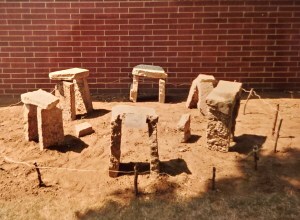
July 15, 2022
Browsing Books at Shepherd.com
Finding a good book is easier thanks to a website called Shepherd.com. Shepherd is trying to make online book browsing more “magical.” They invite authors to share their own books, then share five related books and tell why they chose those specific titles.
Shepherd uses artificial intelligence to find fun ways to connect books to help readers follow their curiosity.

I’ve shared both “Leora books” on Shepherd.com, along with World War 2 stories that are surprising and compelling. It was fun to do, and the concept is so enjoyable. Within the World War 2 section, you can browse books and author’s book suggestions. You can also jump to related topics like prisoners of war or Winston Churchill.
How about the best books on little-known aspects of the Confederate era? (Dennis Peterson)
The best books of surprising stories of the Great Depression. (Mine)
The best Christian fiction books with memorable characters.
Try it out. I think you’ll enjoy it.
For you authors, check out their Shepherd For Authors page. That’s how I started with both Leora books.
July 13, 2022
Family Lockets
Doris’s Baby Locket
Leora Goff Wilson was the oldest in her family and the only one married, with two small sons. She started writing letters to boys in military service in 1918 when the oldest three of her seven brothers were sent to fight in France with the 88th Infantry Division. When baby Doris Wilson was born that August, Wayne Goff was especially taken with the news of the birth of his first niece. He sent money home from France, asking his younger sisters to buy a gift for the baby. Georgia and Ruby Goff chose a locket for baby Doris, large enough for her to enjoy wearing as an adult. They had it engraved “Wayne to Doris.”


First Anniversary
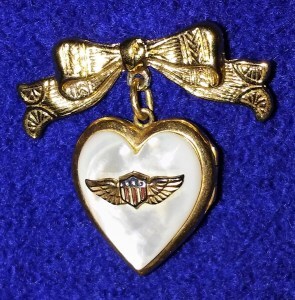
Doris grew up during the Great Depression and was a waitress when WWII began. She married an Iowa farmer who’d become a pilot in Texas.
Marfa, Texas, was so crowded during WWII that Doris and Warren Neal lived in a room in a church. Some people were even living in the Marfa hospital.
So they decided it would be better if Doris returned home for the birth of their first baby, and they could spend a few weeks with her mother’s help. The couple rode the train back to Iowa in March, 1944, with the baby due in late May.
The Neals spent their first anniversary apart, but Warren sent Doris a locket with pilot’s wings on it to commemorate the day–May 16, 1944.
 Photos are from their 1943 wedding. The bow is a pin, added later.
Photos are from their 1943 wedding. The bow is a pin, added later.My Baby Locket
Looks like I used it for teething!
 The bow is a pin, added later
The bow is a pin, added laterDo you have a locket or piece of jewelry that has a family story?
July 11, 2022
What Happened to the Model-T “Roadster”
 The “roadster” started out as a Model T truck, which the two older Wilson brothers drove to Des Moines to join the Navy in early 1934. They’d just graduated from high school and even their dad had no job, and there were five more children still at home. The two older boys had enough to eat, were kept busy, and could even send $5 or $10 home to help with overalls for school and food.
The “roadster” started out as a Model T truck, which the two older Wilson brothers drove to Des Moines to join the Navy in early 1934. They’d just graduated from high school and even their dad had no job, and there were five more children still at home. The two older boys had enough to eat, were kept busy, and could even send $5 or $10 home to help with overalls for school and food.
 When Clabe took off the top of the truck that fall, they called it their roadster. One of the photos is on the cover of Leora’s Dexter Stories. Junior is looking at their pet squirrel Rusty on the fender.In this one, Dale is in the driver’s seat, Junior on the hood, and Dale is eyeing Rusty who is perched on the windshield.
When Clabe took off the top of the truck that fall, they called it their roadster. One of the photos is on the cover of Leora’s Dexter Stories. Junior is looking at their pet squirrel Rusty on the fender.In this one, Dale is in the driver’s seat, Junior on the hood, and Dale is eyeing Rusty who is perched on the windshield. By the end of 1934, Clabe needed to sell the roadster. He never had another vehicle until after finding work as a tenant farmer, about 1940. (They had a “smoking Buick” for a while, then were able to pool their money to buy that brand new 1942 Plymouth.)
By the end of 1934, Clabe needed to sell the roadster. He never had another vehicle until after finding work as a tenant farmer, about 1940. (They had a “smoking Buick” for a while, then were able to pool their money to buy that brand new 1942 Plymouth.)—– Leora’s Dexter Stories: The Scarcity Years of the Great Depression
July 8, 2022
Iowa’s M and M Divide
Iowa might not have the Continental Divide, the mountainous line that determines whether the rivers of the nation run toward the Pacific or Atlantic Oceans.
But we have our own M and M Divide, marking the line for Iowa watersheds toward the Missouri River on the west or the Mississippi on the east.
 That dotted line, from roughly the NW corner of the photo to the SE, marks the M and M Divide. Knowing that there’s a sign marking it just west of Guthrie Center, I wanted to know where it runs through the rest of Iowa.
That dotted line, from roughly the NW corner of the photo to the SE, marks the M and M Divide. Knowing that there’s a sign marking it just west of Guthrie Center, I wanted to know where it runs through the rest of Iowa. Highway 30: This sign and rock, just east of Arcadia, population 525, shows its location in Carroll County.
Highway 30: This sign and rock, just east of Arcadia, population 525, shows its location in Carroll County.

Highway 44: As you drive west of Guthrie Center, you will notice the road climbs steadily higher until you reach the point where a marker announces that this is the “Missouri-Mississippi Divide, Elevation 1440 feet.”
 Aunt Darlene, Sis Gloria, Mom (Doris) at the M and M Divide, Highway 44 between Audubon and Guthrie Center. June 19, 1995. Gloria drove, I took photos.
Aunt Darlene, Sis Gloria, Mom (Doris) at the M and M Divide, Highway 44 between Audubon and Guthrie Center. June 19, 1995. Gloria drove, I took photos.Interstate 80: According to a local, the M and M divide runs through the middle of Adair. “If you take the highway north from Exit 76 on Interstate 80, you are literally driving on it. It’s very close to the water tower with the happy face.”

Southern Iowa: Lorimor, Union County, touts its lofty spot on the M & M Divide.
Even the water draining to the Missouri River eventually ends up in the Mississippi River.
 World Atlas map
World Atlas mapHere is a better version of the map of the Drainage Basins of Iowa, showing where the M and M Divide runs through the state.



